One of the key ways you can dissolve white page fear is to deliberately mess up the page with scribbles and smears of paint or ink. IN this video I use water soluble crayons and brushes to create thin light colored washed to put a bunch of color onto my page and get me loosened up.
Category Archives: Inspiration
Drawing from Life Informs the Imagination
I don’t design my pages. It has never been a thing that I do. I just draw and fit it to the page, occasionally I’ll put some text into a bare area and call it good. In a way the lack of design is design.
As I was working on a video about drawing cartoon faces I stated (paraphrasing here) that when I create a cartoon face I am drawing on all the experience I have drawing faces from photos and life. 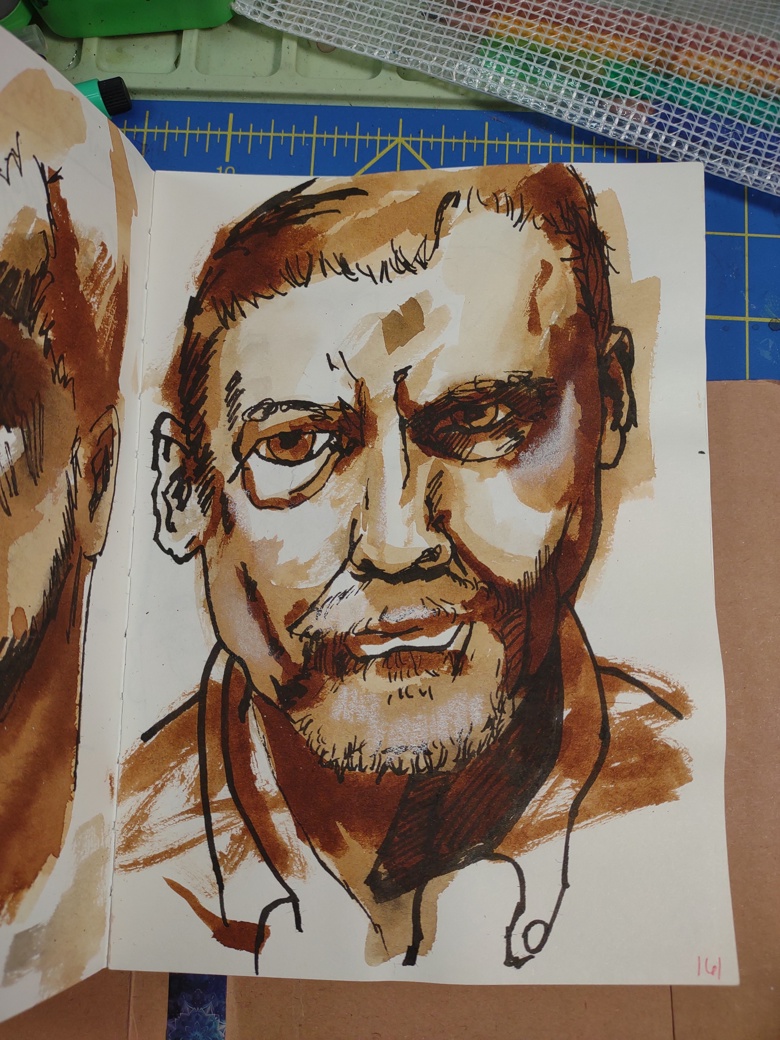
The kids I work with complain about drawing from life, arguing that they need to work on their manga style rather than drawing stuff from life. They hate to hear that all the greats drew and still draw from life on the regular. Every time we put pen(cil) to paper it changes and alters our ability to render for the better.*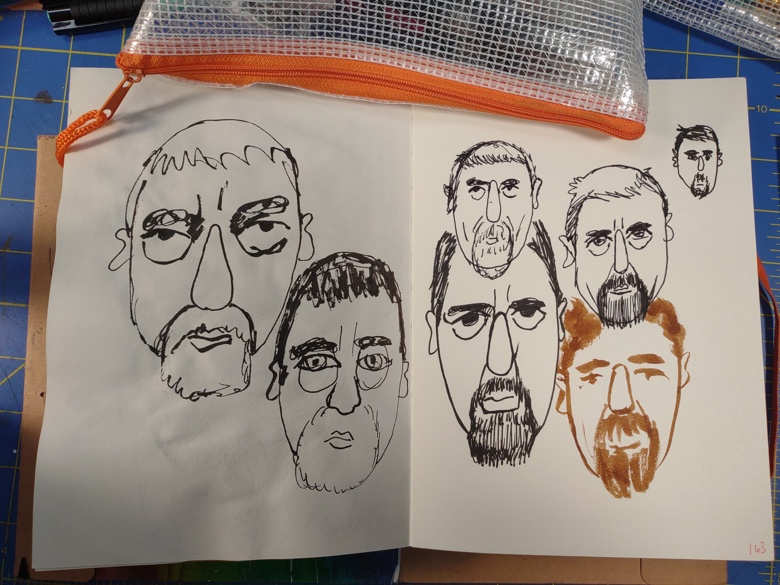
I did a vibey realistic drawing of a face today with pen and ink wash, a favorite technique. Then I went on to draw 7 different version of him with a few different materials. It was and is a great exercise in character design but also in seeing exactly how drawing real but with a focus on vibes and from “life” really informs my cartoon faces. Those characters can feel more REAL because I draw vibey realism.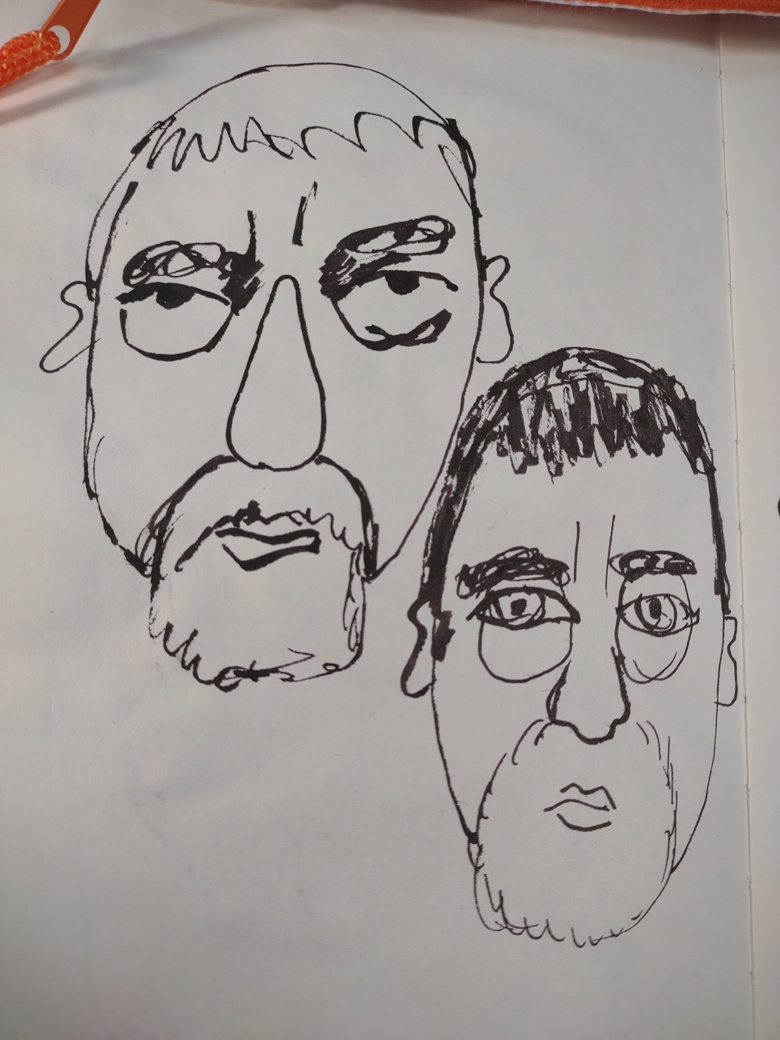
I tested it with a fude nib, 2 types of gel pen, and a brush pen. Each gives a different feel to the cartoon face. 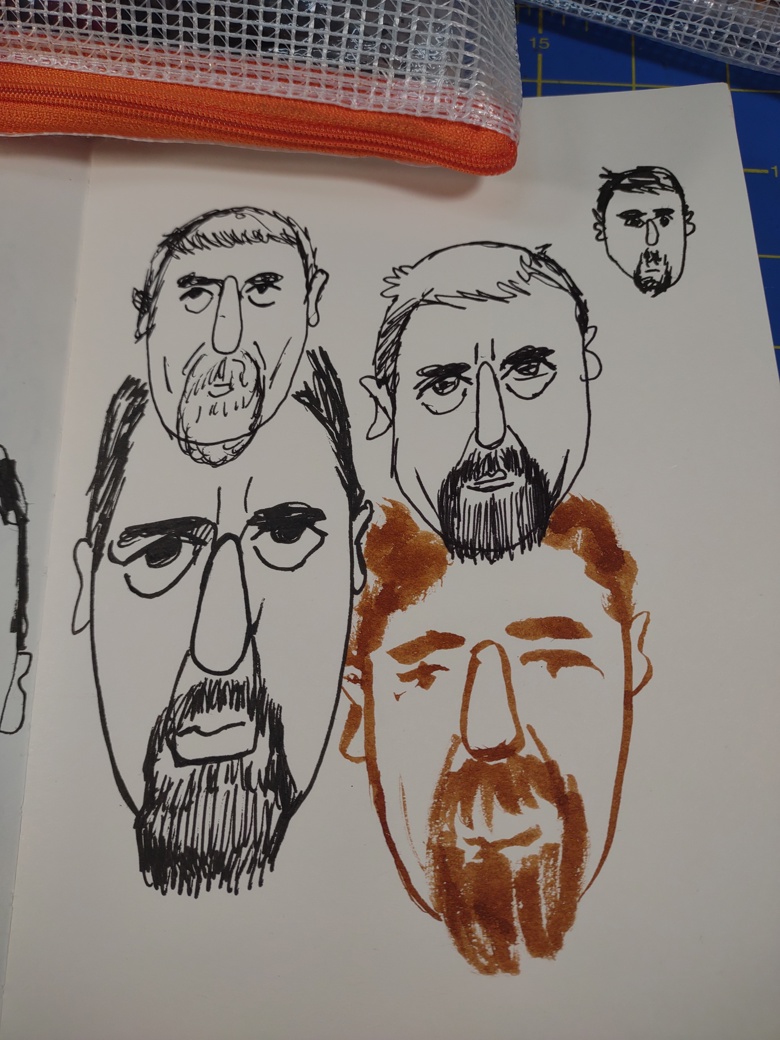
As a further test I’m definitely going to test this idea out with the drawing tablet in Krita.
* We can discuss what I mean by better in a future post.
When Other Artists Inspire
I’ve been watching Drewscape_Art on youtube for a few years. I started watching him because he was making some sweet pens by hand. He doesn’t do that anymore but his illustration career took off. His art style is really cool and deceptively simple. Think Ivan Brunetti or my hero, Linda Barry. He also does great things with color. He combines his hand drawn art with interesting effects in Procreate. When I watch his videoes where he uses Procreate I have some serious iPad FOMO. Which frankly, is saying something since I’m an Android and Windoze person 100%, but a small part of me wants to use Procreate.
Anyway, Andrew posts a lot of videos about creativity and making comix. I think a lot of what he posts directly relates to art journaling. One of his recent videos was about a warm up exercise where you draw random comix panels on a page and then fill it with random blobs and scribbles of midtone ink wash. You then use these shapes to pull images out of. You look and decide what you see, then add in more lines and details until you have a page. you can add words if you’d like. In this particular video he cuts words out of a piece of junk mail. Nifty.
I have to admit I’ve been hooked on this since I watched the video. I had to immediately try this out for myself and oh man has it been bringing me some creative joy. It’s a lot of fun.
First the random panels are pretty random and then you fill them with loose watery ink or watercolor or other media. It’s very freeing to do. Then you let your mind be child-like and creative and play as you see things in the shapes. Then you add in details and maybe more color.
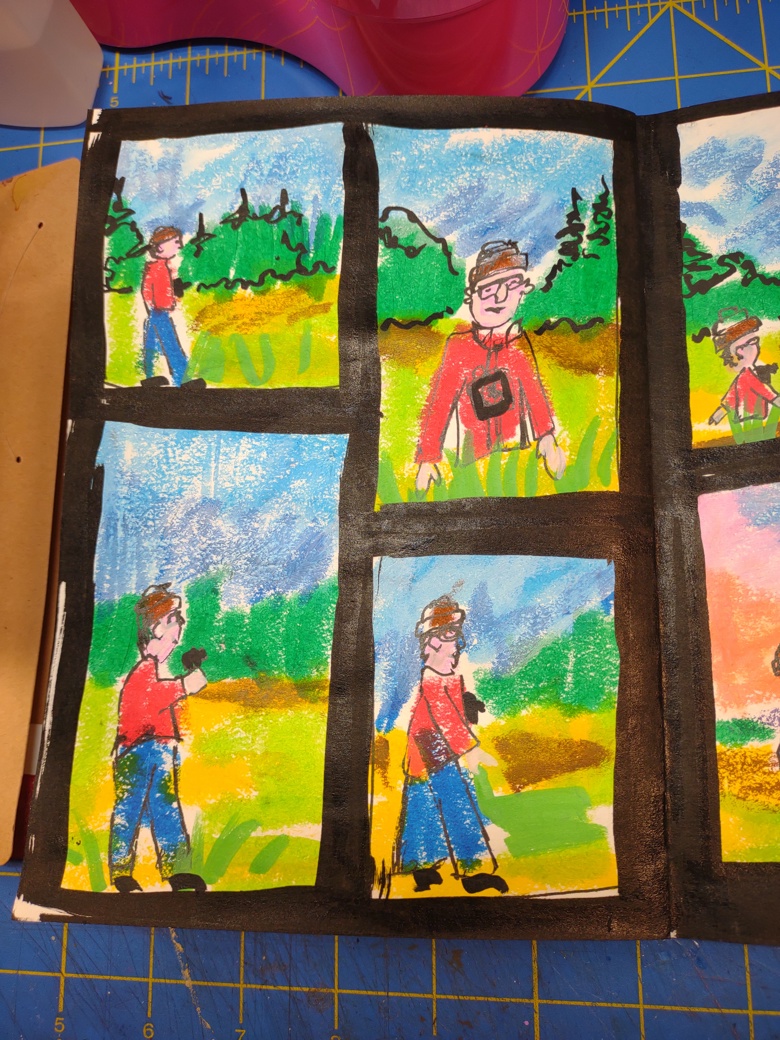

as you can see from the two images above, the materials you use really has an impact on the looseness of the page. IN this case I used paint sticks and they have a rough quality. they are hard to control and eliminate the possibility of details. When using them you have to wait to add in the detail. It’s an exercise in patience.
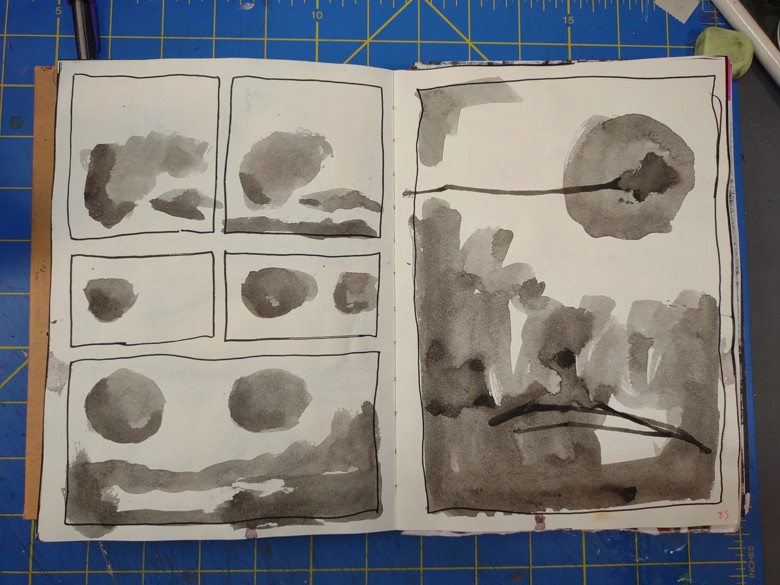
This page was made with my 2 ink wash brushes. One has a light mid tone and the other a much darker mid-tone. I brushed on the light mid-tone and then dabbed in the darker mid-tone. No plan, just sticking to streaks and circles.
This ended up being a page I photocopied and shared withthe kids I worked with. I had them use it for the basis of their own spread. Asking them to look to see what they saw in the blobs and streaks. they then used sharpies to create their images. I’ve done this exercise with a couple of different groups of kids and the results are wild and different every time. And it’s the same for me. See my 2 sessions with photo copies of this page.
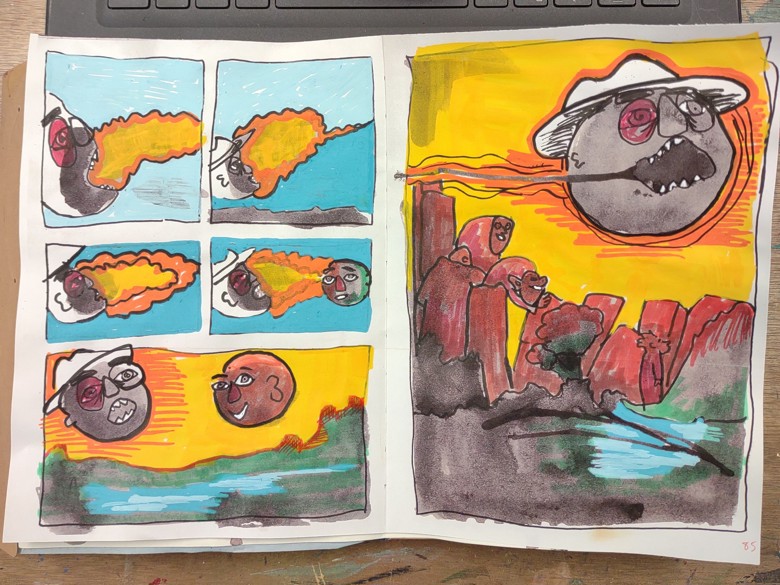
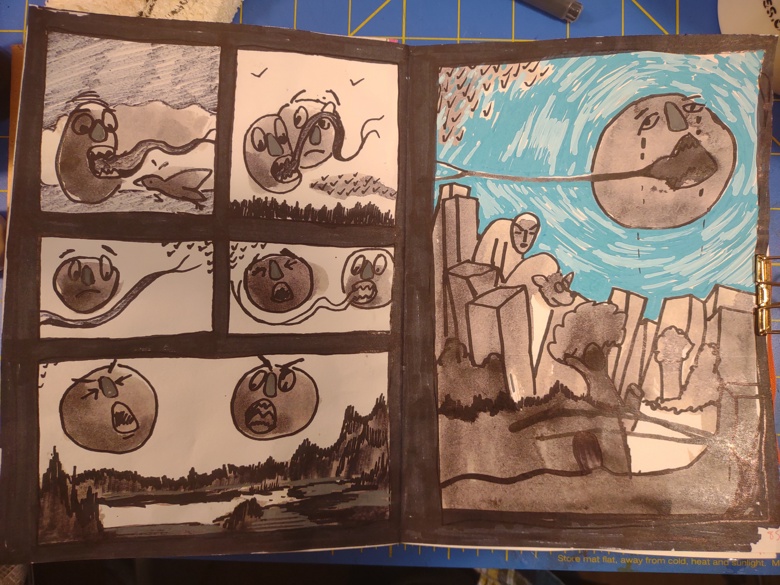
Two very different pages that began the same. Nifty.
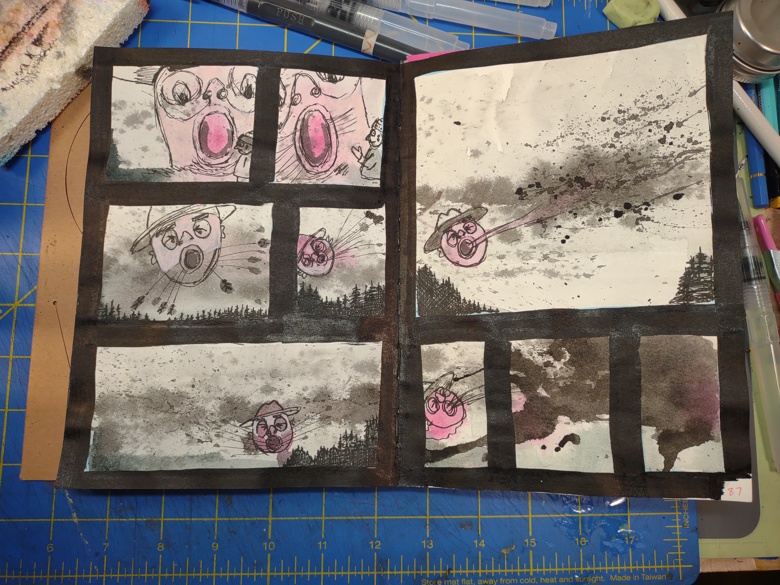
This page started out with panels and ink wash flicked across a wet page. Each panel was wet with a brush then ink flicked across the page to create the loose cloud like areas. I then blobbed on some pink watercolor and let that flow as well. as I brought out the details I wanted to add in the idea of people being sucked into the mouth, so I stared by drawing stick figures then realized I could just do dots. So I flicked more ink wash across the page. While the paper is dry the ink wash doesn’t spread out, it stays in a loose dot.
I have recorded a lot of this process in a few videos that will come out across the month of November. I haven’t captured all of them but I’ve been making more and more of these pages.
They bring me so much joy but each page tells a story of my life in that day, just like any other art journal page.
I’ve scanned and cleaned up an image of the page that I have used with my groups of kids, if you want to try this in your own art journal feel free to download the PDF and print it to make your own Drewscape_art comix inspired page.
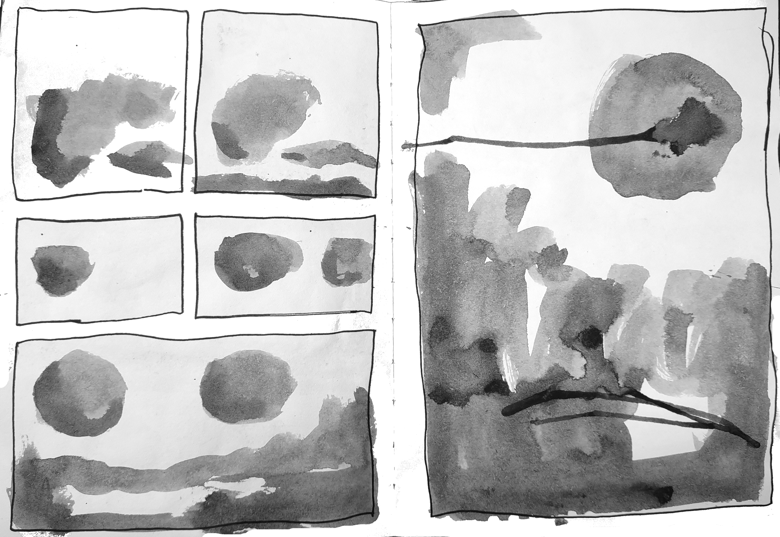
Get a downloadable version suitable for printing here: https://ko-fi.com/s/8389c4d952
Available as a high quality PNG and PDF.
Always Someone There to Remind Me
When I was a pre-teen my Dad bought a beat up Ford Ranger. It had a tape deck that the previous owner claimed had a tape stuck in it. That tape was a copy of Naked Eyes Burning Bridges. I managed to get it out of the tape deck and then proceeded to listen to it on repeat.
Pre-teen me loved Brit synth pop. I think I wore that tape out.
Also I wanted that truck.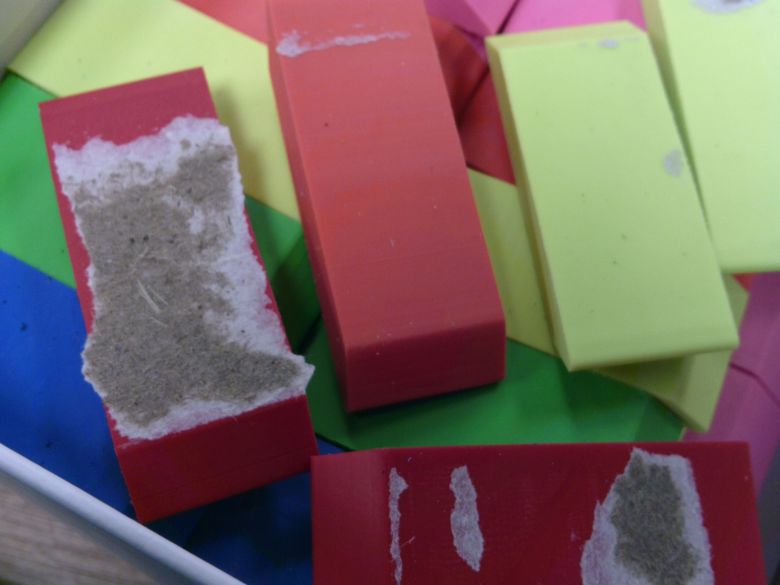
The title I used for this post is a riff on one of the songs on that tape- the actual song was “Always Some THING There to Remind Me” and apparently it has been recorded by quite a few artists.
Anyway, after that intro…
I was reminded today of how there is always someone there to remind me about what they think about me, my art, and how they think I should also feel about all that. And generally they don’t rate me or my opinions very highly. There is always some fool out there ready to tear me down. 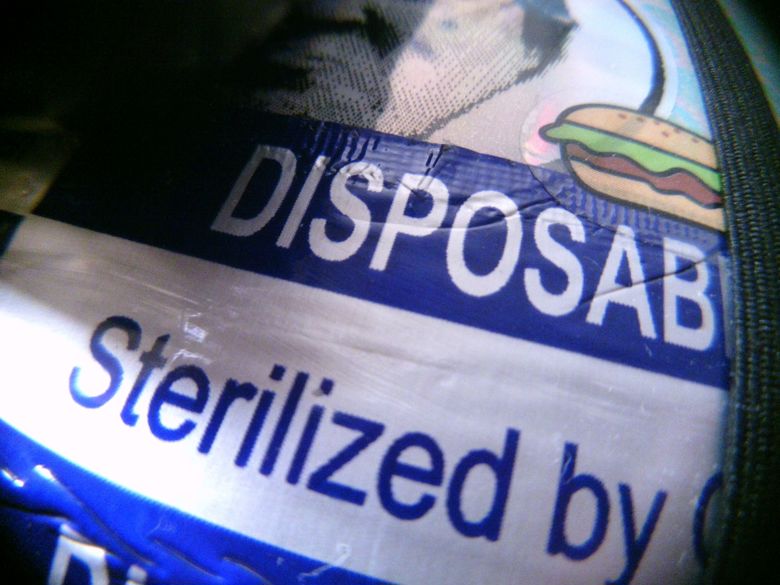
And frankly it’s really hard to weather that storm.
Their garbage opinion always seems to rain down when I’m at my my fragile. When the scaffolding of my self esteem is constructed but don’t have the support braces installed yet.
These people, they are jealous of success. When they sniff out success they want to take a dump on it. When they see my joy they want to dump on it.  This pic has a fun little glitch in it. The wheels do not look like that IRL! I wish I knew how to make it happen again!
This pic has a fun little glitch in it. The wheels do not look like that IRL! I wish I knew how to make it happen again!
These are the worst kinds of people. They just dump on everything and everything. They don’t really care who they dump on, they simply want to tear down people in a misguided attempt to build themselves up.
I use a generic THEY here because we all have a dumper in our lives. I’ve referred to these people as Dream Dumpers before. These are the people when you tell them about your favorite new cheese/ TV show/ art material/ movie/ hobby/ etc… they just dump on it.
Their capacity for finding the worst in everything is mirrored by how awful they feel about pretty much everything- they hate their boss and their job, as well as just about everything else in the world. But mostly they hate themselves.
I write this not to find empathy, though I do have empathy for people who hate everything. I write this because it helps me to think about the hate that these folx spew outward, they also spew it inward.
Imagine how horrible I/you feel about what these folx say to you either in person or in a social media comment. Then imagine them saying it back to themselves over and over and over again.
How awful.
Garbage in. Garbage out.
It gives me some perspective. But also it helps me to see that the Dream Dumper, their perspective is skewed. They can’t see the joy because all they have is hate. They dump on good happy things out of jealousy, even if they don'[t know they feel jealous, how can they actually know how they feel when everything is shrouded in hate?
Dream dumpers suck the joy out of pretty much everything.
Re-post from my Ko-Fi page, get my posts much earlier there.
Gear or Supply Guys
A type of dream dumper that I especially loathe is the Gear Guy. (It goes without saying that the Gear Guy is a gendered joke and the GUY can of course be a GAL or just person.) 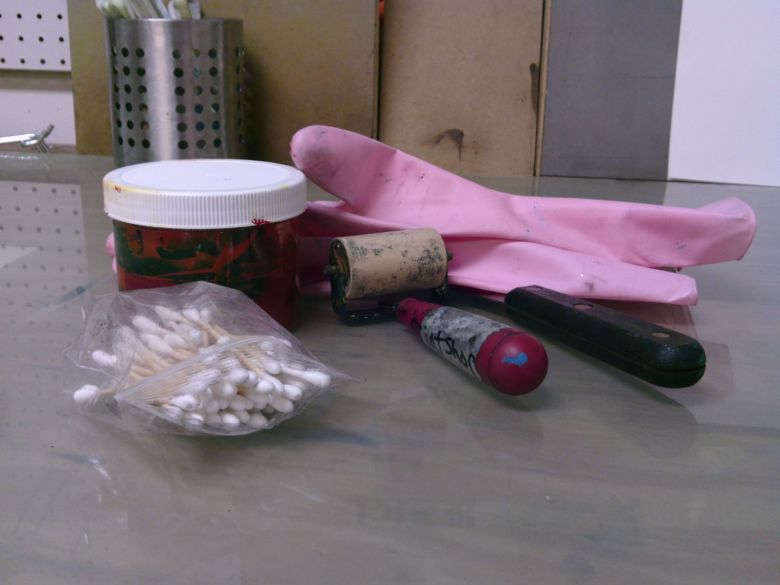
The Gear Guy is that person who asks you what you are using and then smirks and tells you they have the newest model of your beaten up used piece of equipment.
It’s a wallet wag.
I see this so often when it comes to cameras, watercolor brushes, and bicycles.
I use my action camera for everything. Because it eliminates shake it’s great for taking pictures. I can also adjust the settings and get a nice shot. I have added a step up ring to it it so that I can use close up lenses and filters! Cool. Nifty hack!
Most of all, I know how to use the action cam, and I have it with me all the time.
I also always have a toy camera in my bag. I won’t write here about my undying love of toy cameras, but I looooove them.
Anyway, I was out with some people I know and I pulled my old trusty modified Osmo Action 3 out, slapped on a 2x close up filter and took some pictures. A Gear Guy came over and asked me about the cam. I explained the ring and filter situation. He smirked and held up his Canon with a $1600 lens.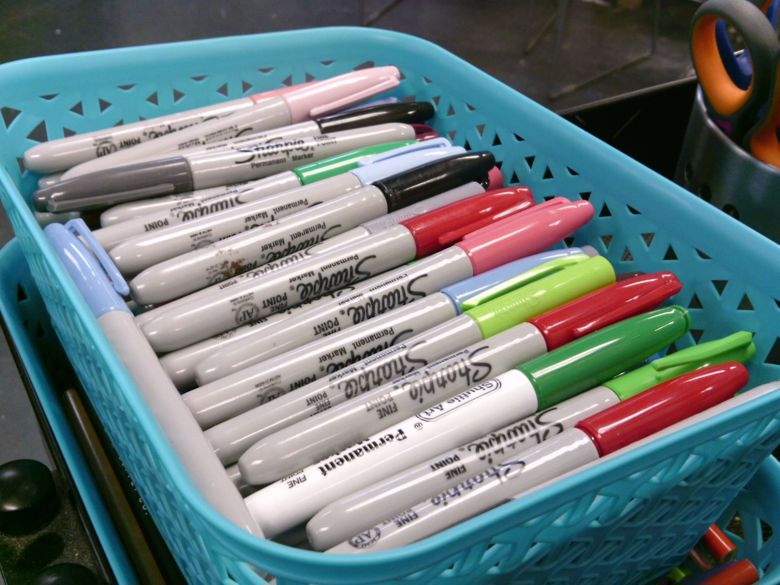
Me being me, I lifted up my camera and snapped his picture. I laughed as I walked away.
His attempt to make me feel small didn’t work because I disarmed it with humor.
But it still grinds my gears.
Having the money to buy a thousand dollar camera body and slapping a $1600 lens on it doesn’t make him the better photographer. (I am a shitty photographer and I know it.) It means he has more money and more tools to prop him up.
Expensive tools aren’t a magic wand to make better art.
Cheaper tools used well can make great art. Yes cheap tools can be frustrating to make with, but if you are careful and buy well, you can find good cheap tools. Even if you aren’t, I’d rather see someone find an amazing cheap tool and brag about their deal than listen to some Gear Guy brag about his $150 water color brush he flew to Japan to buy.
This is why I suggest cheap journals/sketchbooks. Fill them up, burn through them with all the messes and then buy another one. Feel no guilt for using cheap sketchbooks as your journals.
An expensive journal won’t make your art journal better. Only time and effort will pay off. Spend time to find your favorite art journal. Most of the time the journal expense will be somewhere in the middle of the cost range.
Re-post from my Ko-Fi page, get my posts much earlier there.
What Do I NEED to Create?
Back in the day I used to soak up videos and blog posts about art making gear. Everyone’s equipment fascinated me. Part of this was curiosity about processes but also wanting to know HOW to use that equipment.
And when I write equipment I mean everything from paint to brushes to paper to cameras and software used to edit the very video I watched.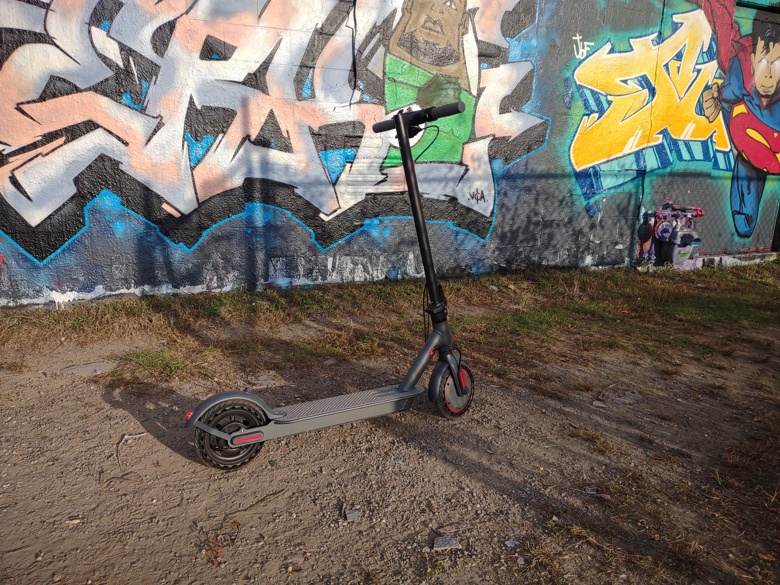 Yes, I picked up an eScooter. Yes it’s probably too dangerous. But holy hell is it FUN!
Yes, I picked up an eScooter. Yes it’s probably too dangerous. But holy hell is it FUN!
I have a theory that most of us who get caught up in GAS (Gear Acquisition Syndrome) are like me- just want to know all the things about the things we use to create. I want to know your processes so I can develop my processes.
As I work on my latest videos and possible zines, I have been asking myself how do I create and write a tutorial that doesn’t feed into the GAS making machine?
I have been asking myself the question: “What do I need to create?”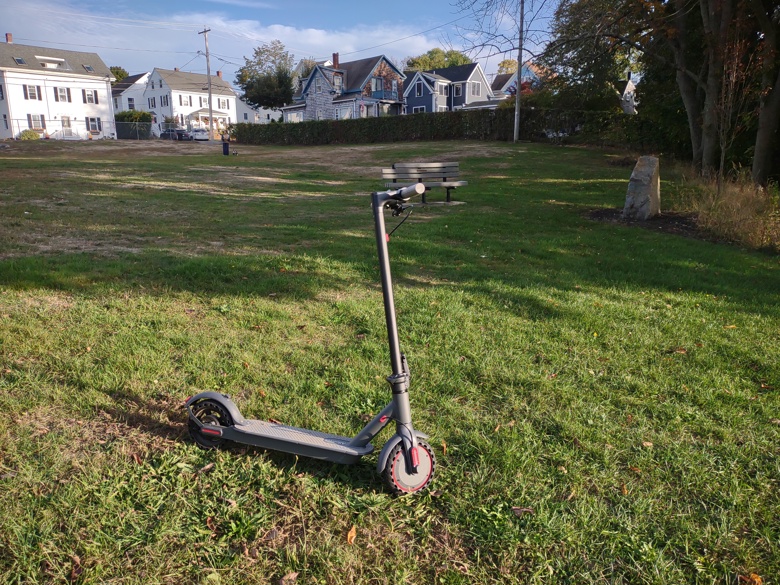
I ask this as I reach for materials.
I have access to every material I could possibly want and then some. If I don’t have it in my home studio I have it at work. If I don’t currently own it or have access to it I can order it and have it here in a few days.
GAS and SABLE (Stash Acquisition Beyond Life Expectancy) are two reasons I started to tell myself and say in my videos and posts, “Use what you have.” “Buy singles when possible.”
But really when you dial it down to basics what do we need to create? I think this is going to vary for everyone.
I need a sketchbook of some sort and either a pencil or a pen.
That’s it.
It’s simple.
I also think I make some of my best art when I strip it down to simplicity, and allow myself to fully embrace that material. Then when I open up and add in color and wash and more, it feels decadent and alive.
Every art piece is a way to learn more about myself and my interaction with the world around me. Even when it’s “just” in my journal, it is important.
Anyway, the scripts (we can loosely call what I’m writing scripts) for my tutorials encourage people to strip back their practice to the most simple they feel comfortable. Pen. pencil. Simple. Add color to the mix later. Explore black and white then add color.
Simple.
The difficult thing is that simple is never easy.
Re-post from my Ko-Fi page, get my posts much earlier there.
Figuring Out This Balance Thing
It’s been a hot minute between posts here. It seems i Have trouble balancing my life.
Every summer it is the same thing, it gets warm and I have fewer work days with kids and time off, so I ride my bike. Which, excuse the drama, has saved my life in the same way journaling has in the past.
I know I’ve written a bit here about my health struggles with Type 2 Diabetes, but riding my bike has allowed me to get down to one med for my blood pressure and one med for the diabetes. Wild. My blood sugars are generally pretty even and my blood pressure has been good enough that my doctor said I don’t need to come in and see her until next year, unless I have an emergency.
All summer long all I really wanted to do was ride my bike. I had a great time doing it. I’ll hit 1100 miles ridden this week. 1000 of those miles on a modified Walmart bike. The rest were on a vintage Kona mountain bike.
Anyway, if you want to hear and see more about my health journey you can check out my health and wellness channel, Less is More Healthy on youtube.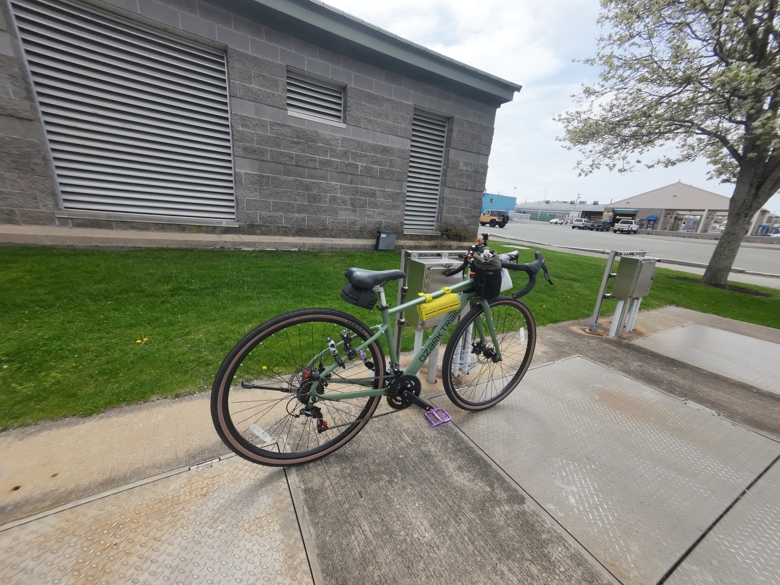
I was recently able to pick up the Osmo Action 5 action camera. This is great for the health channel and the art channel. First off, when I’m recording me drawing with a POV camera, the Action 5 is better than the old Action 3. But this also means that I can put the Action 3 into my overhead camera mount and leave it there. 
This means a lot of things. First off It eliminates a lot of set up and take down that has stopped me from recording my art making in the past. Even though I set up a nearly permanent mount on the overhead rig where I can just clip the Action 3 in and out of. No one said that decision paralysis makes any sense. Now the 3 will just live on the mount most of the time, ready for me to hit record. This also means that I can record audio AS I WORK. My old Cannon doesn’t have an audio in port and the mics on the budget cams is trash.
While I love a voice over, sometimes it’s more intuitive to record as I work.
This also means that if I can get my shit together I can do some livestreams. I used to LOVE doing livestreams. Except for the trolls, but hopefully I’ve got those dudes all blocked.
I did some drawing this summer but not a lot. I drew some boats when I rode out to Manchester-by-the-Sea * and I drew trash while I waited for the train. 
People aren’t impressed with my drawing trash. Which has brought up a lot of thoughts around the purpose of an art journal/visual journal and deciding NOT to draw pretty things. I may have to do another series where I draw used tea bags again.**
At work I fired up our Vandercook press and it was everything I’ve been missing in art making. So I’ve decided that all my groups will be making posters and using the press this year at some point. I can’t wait. This also means I get to use the press more. I REALLY can’t wait.
I’m also going to do a section on keeping a visual art journal.
Which brings me to my hopes for this Ko-Fi page and Comfortable Shoes Studio the YT Channel and blog. I’ve been working on a couple of classes which will include some hand drawn printables, possibly bundled into a zine, and a video series to support it. I’ve been writing my ass off and gathering ideas for this project. Yesterday I made myself a template to create the blank pages with non-photo blue pencil and I’m deciding how I want them to look.
I’m blocking up a little bit, because I want them to look like my work notebook/sketchbook pages and my Every Thing Every Where journal pages. I’m totally over thinking it.
My goal for this week is to loosen up and commit to making one of the pages of the handouts and zine.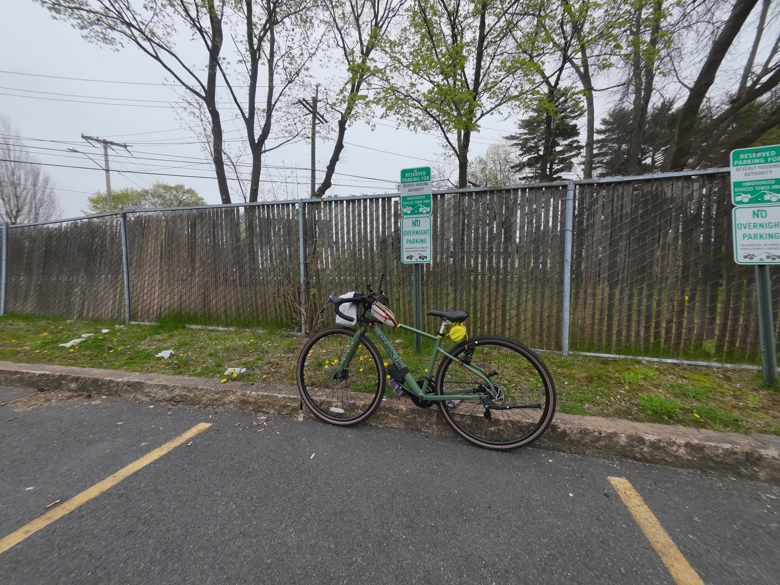
*MbtS is almost as bougie as it sounds. It’s not as bougie as Magnolia, which has a corporation dedicated to keeping it’s private beaches private and keeping out of towners off the beach.
**Tea bags are a useful drawing model. First off if you make tea you will have them. Secondly you can easily pose them and they stay in place. Finally The forms involved are great- loads of shapes and lines to play with drawing. Yeah I just talked myself into it. I’m going to draw some trash.
Re-post from my Ko-Fi page, get my posts much earlier there.
It’s Not So Commonplace
Carefully copying over sections of text seemed painful to me. I had always hated copying over sections of text when I was younger, why would I recreate that for fun?
I liked the idea of collecting quotes but not if I had to copy them over.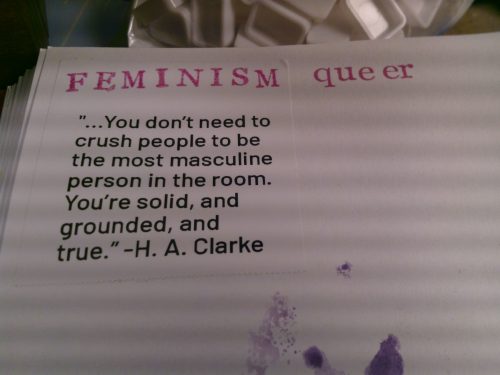
Fast forward to now, I read most of my books on a Kindle and highlights are saved in a digital notebook. If I read something online I can collect it in Google Keep or Milanote* or some other service. Through digital services I’ve been able to collect these scraps of info that hit me in a moment as I read and then never look at them again.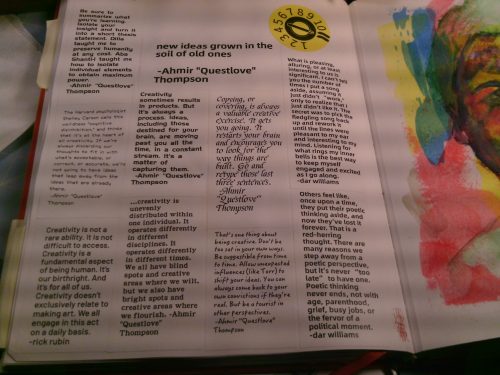
Well, until now.
In the past I’ve printed off some of these quotes with my regular letter size printer, trimmed that down and then slapped it into my Every Thing Every Where (ETEW) book and called it good. Then I got my small thermal printer and that opened up the world of slapping quotes into my ETEW Book.
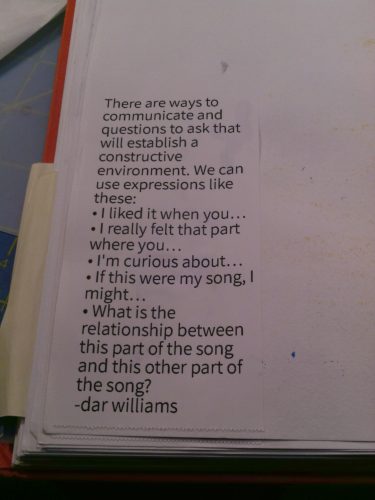
I started out with the regular thermal paper and a glue stick. Then I became aware of thermal sticker paper and I started to print off quotes and stick them in my pocket notebooks. My poor Field Notes was thicc with quotes, spine straining under the bulge.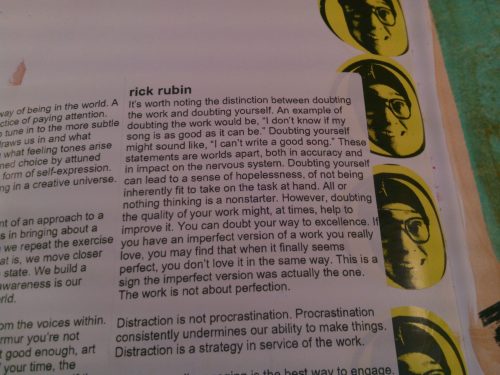
Last night I sat down with my thermal printer and a roll of white sticker paper and printed out some quotes from a variety of books on creativity and creative processes and made pages in my ETEW Book. The quotes are neatly arranged and legible. A feat never accomplished when I had carefully copied over important info with my handwriting. 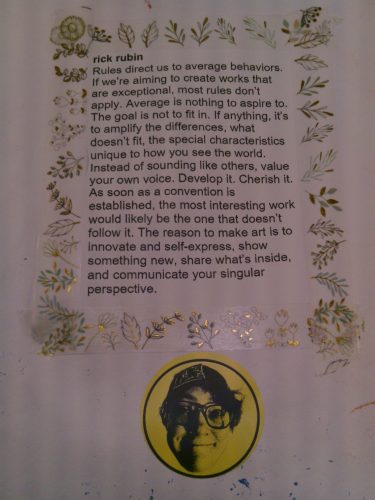
This has made me think of other styles of journaling that I have not used because it required a lot of copying or writing. Things like working from prompts and prompt cards.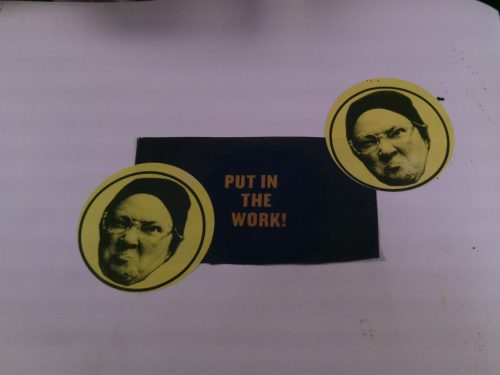
Put in the Work came from a coffee bag! It seemed appropriate for this journal.
*Milanote link is a referral link, I get extra storage space if you sign up. I just started to use it and like how I can arrange things like it’s a sheet of paper on my screen. It’s great for my visual thinking style.
This is a repost from my Ko-Fi page. Posts here are posted there a week in advance for supporters. Some posts there are public at the start, other posts are for supporters only. Not all posts will be republished here. If you like what you read here, head on over and consider buying me a coffee.
Working with Budget Art Journaling Supplies
It doesn’t make a lot of sense to buy all kinds of budget art journaling supplies if I don’t use them? Or show them in use. I’ve made a series of follow up videos using all the supplies I’ve picked up at Dollar Tree, Walmart, Target and 5 Below. NOt all the videos are live yet, but these are. Enjoy!
More to come!
Do you like these videos? Check out my ko-fi page and think about buying me a coffee. It helps me purchase supplies for these videos and keep the content flowing.
Budget Art Journaling Series
I’ve been working on my creative YouTube channel, attempting, seemingly in vain to remonetize it. One of the thing that was asked of me repeatedly and often before I stopped making videos, was, “How do I get started with art journaling without spending a lot?” I always answered this with the idea of buying one or two of a material instead of a giant set of them.
But I considered that there might be another option.
I thought about what I need to work in my art journal and I came up with these items:
- A journal of some sort, a composition book works a sketchbook works
- a black ink pen. I need black ink for sketching.
- Something to add color- doesn’t matter what, this can vary
- An adhesive for adding in ephemera and other collage elements.
I then decided to visit a few shops to see what I could get for $10, $20, and $25. Not big budgets but enough where you can get the basics if you shop carefully.
I visited Dollar Tree, Walmart, Target and 5 Below. The videos document what I chose to get with my money and then there are follow up videos using the materials in an art journal so you can see that I’m not just blowing smoke.
Here are the videos of the shops:
The 5Below video is upcoming and in the rendering queue.